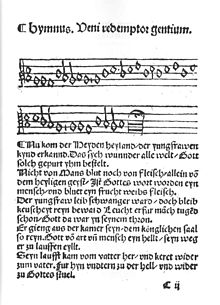Nun komm, der Heiden Heiland
| "Nun komm, der Heiden Heiland" | |
|---|---|
| Hymn by Martin Luther | |

"Nu kom der Heyden heyland" in the Erfurt Enchiridion
|
|
| English | Now come, Saviour of the heathens |
| Occasion | Advent |
| Text | by Martin Luther |
| Language | German |
| Based on | Veni redemptor gentium |
| Published | 1524 |
"Nun komm, der Heiden Heiland" (original: "Nu kom der Heyden heyland", English: "Now come, Saviour of the heathens") is a Lutheran chorale of 1524 with words written by Martin Luther, based on Veni redemptor gentium by Ambrose. It was printed in the Erfurt Enchiridion of 1524. The chorale was used as the prominent hymn for the first Sunday of Advent for centuries. It was used widely in organ settings by Protestant baroque composers, most notably Johann Sebastian Bach: he set it as the opening chorale prelude BWV 599 of Orgelbüchlein; and three times—as BWV 659 (one of his best known organ compositions), BWV 660 and BWV 661—in his Great Eighteen Chorale Preludes. Bach used the hymn in his chorale cantata Nun komm, der Heiden Heiland, BWV 62 (1724) and in the opening chorale fantasia of his earlier cantata Nun komm, der Heiden Heiland, BWV 61, BWV 61 (1714). Max Reger composed a chorale prelude as No. 29 of his 52 Chorale Preludes, Op. 67 in 1902.
This chorale continues in modern usage, both in liturgically oriented Christian hymnals (for example, the Lutheran Book of Worship) and as the cantus firmus for organ compositions. In Brian Easdale's score for the 1948 film The Red Shoes, the melody from the chorale is heard as a theme late in the ballet, punctuated by ringing bells, brass instruments and a grand piano.
...
Wikipedia
